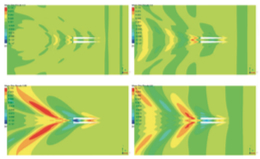Propulsive Qualities of Catamaran Vessels
DOI:
https://doi.org/10.25043/19098642.125Keywords:
Catamaran, sea-keeping, propulsive qualities, CEHIPAR, advance resistance tests, hydrodynamicsAbstract
During the last decade the civil and military applications of catamaran vessels have developed rapidly. Their particular area of proliferation is the short sea shipping where their power, economy, habitability and behavior have provided them a market niche. The rapid market growth ha caused catamarans to experience design modifications regarding size, speed, cargo diversity (passengers, vehicles, containers).
The purpose of this article is to show the work developed by the El Pardo Hydrodynamic Experiences Channel (CEHIPAR) regarding the propulsive qualities of catamaran vessels. This work is the result of the need expressed by the Ministry of Defense for provision of technical assistance and scientific research for an I+D program that established more adequate program parameters for a catamaran-type vessel from the propulsive point of view, in relation to its size and shape, so that it has the adequate information and trustworthiness when suggesting a vessel of this type as an alternative to other platforms, always within the scope of application of patrol-type or quick-attack-type vessels.
Downloads
References
ALAEZ, J. (1991). Catamaranes de alta velocidad. Publicación 130, Canal de Experiencias Hidrodinámicas de El Pardo, Madrid, España.
GARCÍA, A y BOBO, M. (1999). Programa MJ-3A. Predicción de potencia-velocidad para buques rápidos. Canal de Experiencias Hidrodinámicas de El Pardo, Madrid, España.
GARCÍA, A. y RIOLA, J. (2013). Proyecto hidrodinámico de un buque de escolta oceánico tipo trimarán: Dimensionamiento, diseño, estudio numérico y experimentación. Congreso DESEi+d 2013, Madrid, España.
LEVI, C. y SALHUA, C. (2007). Modificación del sistema de propulsión de un catamarán de pasajeros. XX Congreso panamericano de ingeniería naval COPINAVAL, Sao Paulo, Brasil.
MACFARLANE, G. y DAIRE, N. (2011). The influence of catamaran hull form on added resistance in head seas. 11th International Conference on Fast sea transportation, Hawai, USA.
MICHEL, J. (1898). The wave resistance of a ship. Philosophical magazine, 45, pp 106-123.
MILLWARD, A. (1992). The effect of hull separation and restricted water depth on catamaran resistance. Trans. R.I.N.A, 134.
MORAES, H., VASCONCELLOS, J. y LATORRE, R. G. (2004). Wave resistance for high-speed catamarans, Ocean Engineering, 31, 2253-2282.
PHAM, X., KANTIMAHANTHI, K. y SAHOO, P.K. (2001). Wave resistance prediction of hard-chine catamarans through regression analysis. 2nd International Euro Conference on High Performance Marine Vehicles, Hamburgo, Alemania.
RIOLA, J., PÉREZ, R. y DÍAZ, J. (2013). Análisis del comportamiento en la mar de buques de guerra multicasco. 52o Congreso de Ingeniería Naval e Industria Marítima, Madrid, España.
SAHOO, P., SALAS, M. y SCHWETZ, A. (2007). Practical evaluation of resistance of high-speed catamaran hull form. Ships and offshore structures, 2, pp 307-324.
SALAS, M., SAHOO P. y LUCO, R. (2008). Avances en la estimación de la Resistencia de Catamaranes. SHIP Science and technology, 2, (3), pp 39-46.
SARLES, C., GELLES, B. y MALARKEY, A. (2011). An investigation into the effect of section shape on the interference resistance of catamarans. 11th International Conference on Fast sea transportation, Hawai, USA.
THOMAS, G., TOMIC, P. y TUITE, A. (2006). High-Speed catamaran or monohull? How do you choose? 5th Conference on high performance marine vehicles (HIPER ́06), Lancester, Australia.
ZAGHI, S., BROGLIA, R. y DI MASCIO, A. (2010). Experimental and numerical investigations on Fast Catamarans Interferente Effects. 9th International Conference Hydrodinamics.

Published
How to Cite
Issue
Section
License
The authors who publish in this Journal certify that:
- The work submitted for publication in The Ship Science and Technology journal, was written by the author, given that its content is the product of his/her direct intellectual contribution.
- All data and references to material already published are duly identified with their respective credits and are included in the bibliographic notes and quotations highlighted as such.
- All materials submitted for publication are completely free of copyrights; consequently, the author accepts responsibility for any lawsuit or claim related with Intellectual Property Rights thereof, Exonerating of responsibility to The Science and Technology for the Development of Naval, Maritime, and Riverine Industry Corporation, COTECMAR.
- In the event that the article is chosen for publication by The Ship Science and Technology journal, the author state that he/she totally transfers reproduction rights of such to The Science and Technology for the Development of Naval, Maritime, and Riverine Industry Corporation, COTECMAR.
- The authors retain the copyright and transfer to COTECMAR the right of publication and reproduction of the work which will be simultaneously subject to the Creative Commons Attribution License (CC -BY) , which allows the license to copy, distribute, display and represent the work and to make derivative works as long as it recognizes and cites the work in the manner specified by the author or licensor.
- For more information about the Creative Commons Attribution License (CC -BY) and his use and scope, please visit the following web page https://creativecommons.org/licenses/by-sa/4.0/legalcode








